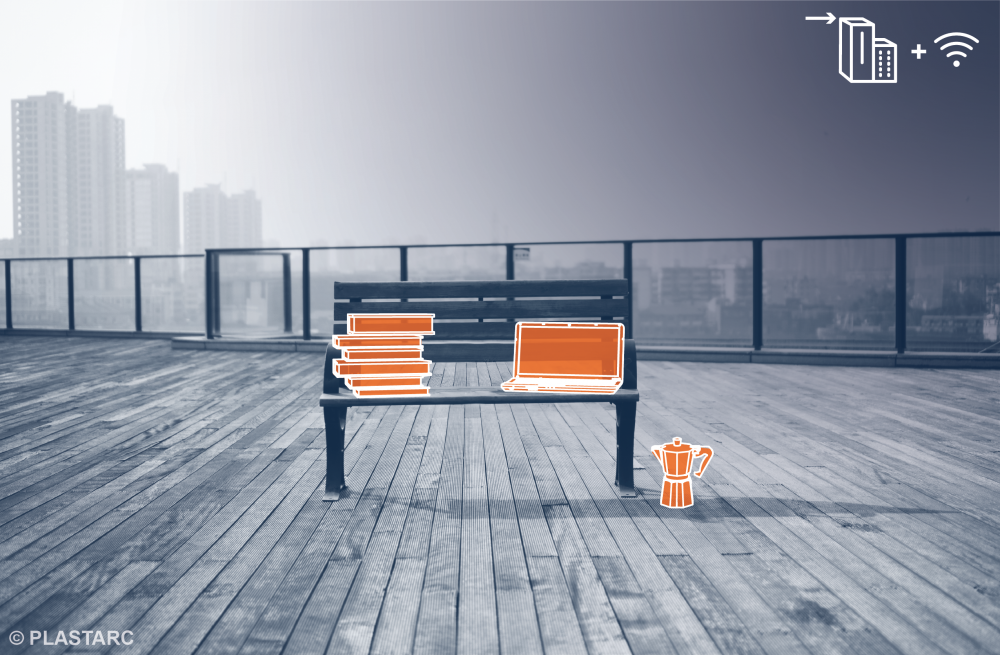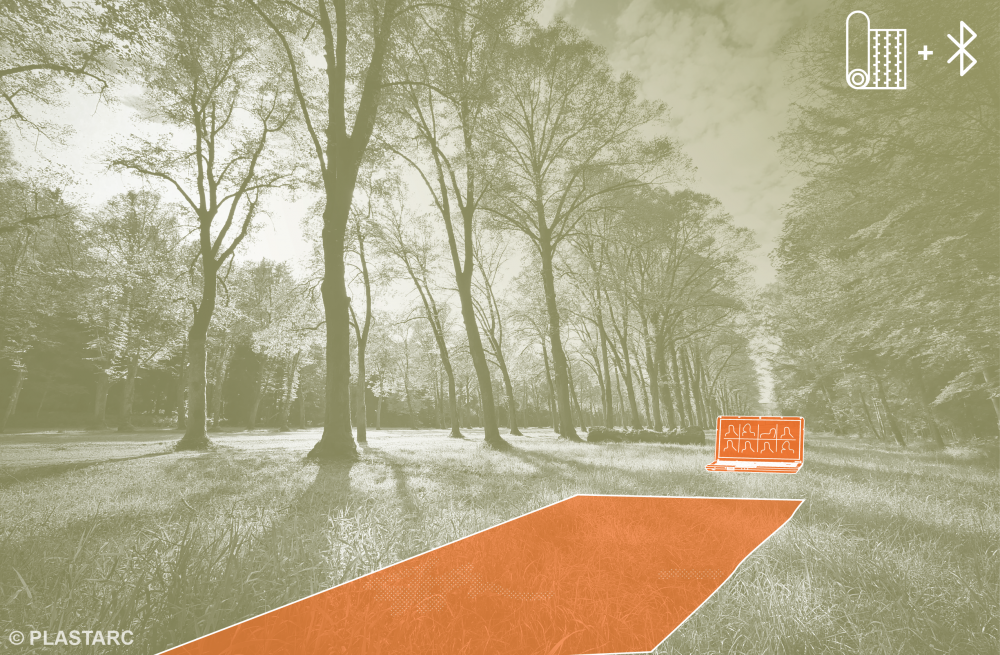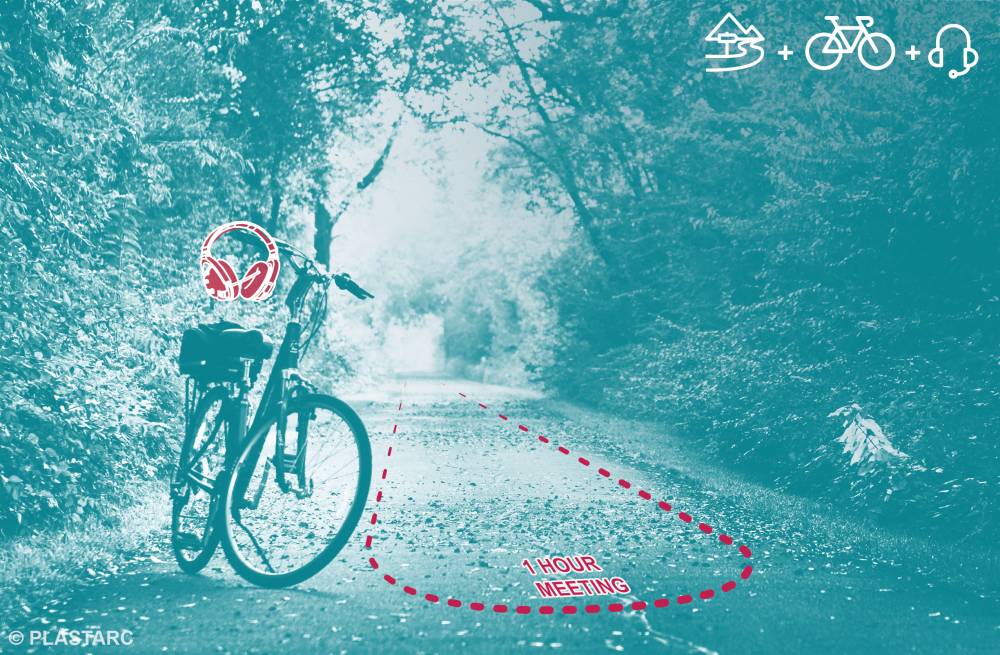This summer, there are more reasons than ever to work outside.

No matter how comfortable and packed with amenities today’s workplaces may become, there’s still something special about being outside. Daylight, fresh air, consistent exercise and inspiring scenery can give a significant boost to office workers who might otherwise be stuck at a desk for most of the day. Now, because of COVID-19, there are likely to be long-standing challenges to working in traditional environments. The science is now showing that enclosed spaces with shared airflow are driving transmission more than use of shared surfaces. With these challenges in mind, there is no better time than now to figure out how to start working outside.
A year ago, we wrote about evolving trends in outdoor design. We are now on the cusp of a golden moment for the outdoor office. As work has become more mobile and connectivity has become more ubiquitous, it has become progressively more difficult to defend the status quo of the office. When science has demonstrated that circadian lighting improves performance and wellness, should we really be asking people to work without it? When some businesses are turning off their HVAC systems and asking people to open the windows because of COVID-19, can we really still say that air of a specific temperature is more important than air that is fresh?
Infrastructure requirements like networking access or specialized workstations are no longer the reason most people come to a workplace. Now, the principal benefit of the traditional office is control. The lighting is the same every day, rain or shine. The temperature, humidity and air quality do not vary. These systems are purportedly in place to support comfort for the average user. But in reality, no user is average, and many environments fall short of even this modest goal.
Environmental control also comes with a cost beyond the financial and ecological costs of heating, cooling and lighting large enclosed spaces. People are now ordinarily spending more than 90 percent of their time inside—in their workplaces, vehicles, homes, or elsewhere. This is at odds with most of human evolutionary history. It is a disconnect so profound that “nature deficit disorder” and “psychoterratica” have entered the lexicon to describe it.
To combat this self-imposed exile from the natural world—and the attendant stress and health effects—designers have turned to practices such as biophilic design, which incorporates elements of nature into the built environment. By increasing exposure to daylight, plant life, water and a variety of landscapes, this approach has been shown to be beneficial to both human health and workplace performance. We are big fans of biophilia, but why stop there? The real purpose of the workplace—to support collaborative work—may actually be served better when people go outside.

Outdoor Inspiration
The trendy practice of forest bathing offers perspective. Despite the name, it has little to do with a bathroom (though we’re fully in favor of more innovative restroom designs!) Rather, it refers to purposeful and mindful immersion in nature. Originally popular in Japan, it has been shown to benefit both physical and mental health and to decrease levels of hostility and depression. An interesting finding from this research is that people are positively impacted by being outdoors even if they do not enjoy it! It’s not just that going for a walk is pleasurable; people see benefits from being outside even in conditions that are not comfortable, such as very cold or hot temperatures.
Bringing these positive benefits to more people is part of what’s driving a movement to return the outdoors—not as a temporary relief from the indoor office, but as the default. Outdoor work environments have become increasingly common in recent years, particularly in the less urban parts of San Jose and San Francisco. The trend is not limited to just the Bay Area or even just to traditional offices; L.L. Bean and Industrious recently showed off their outdoor coworking prototype (pun-ily named “BeAn Outsider at Work”) in Manhattan’s Madison Square Park.

Outside is the Default
A few years ago, members of our team were providing workplace strategy to the National Park Service at Grand Teton. As one of the jewels of the national park system, Grand Teton does not want for gorgeous, majestic vistas. As inspiring as their environs, however, were the workplace habits of the team.
For example, the default venue in which park staff conducted a one-to-one meeting was a walk together outside. This is a great place for almost any company to start. It requires almost zero investment in infrastructure and is immediately beneficial; being immersed in nature for even 20 minutes can measurably improve wellbeing.
The outdoor-first frame of mind extends to other circumstances as well. Larger meetings at Grand Teton might happen at covered picnic tables. Many state and national parks are equipped with outdoor amphitheaters that are often used for both public programs and staff functions. This may actually make these programs more effective, as going outside improves memory and attention.
While not every workplace is surrounded by such a picaresque landscape, most could do more to enable a seamless experience of working outside. People continue to sit at desks inside because they think that is how work is supposed to look and feel because that’s how office work has looked up until now. The COVID-19 moment has thrown all of that out the window; people have quickly seen that work can happen anywhere.
Getting Outside Right
In order to make outdoor work effective and sustainable, there are some complexities that need to be tackled. Like any design challenge, these relate both to the physical aspects of great workplace and the organizational change required to enable people to perform well.
There are a few areas in which nature can sometimes deliver a bit too much of a good thing. Daylight is one them. It is generally considered to be a good thing in architecture, but daylight on a computer screen is less so. Unless you’re keen to buy one of these classic garments (or sew your own!), you’ll need a laptop with a transflective screen. In a pinch, polarized sunglasses may also work.
Acoustics are also an important consideration. Wind can be a major distraction over the phone—far more than it would be in person. Designating parts of the outdoor environment that are relatively sheltered from the wind as outdoor “phone booths” can help.
As for work surfaces, many furniture companies now offer outdoor lines, including Crate and Barrel and Design Within Reach (DWR). These options often channel resimercial design, which marries the comfort and versatility of simple home furnishings with the needs of a commercial office environment.

Progress in Business Practice
If outdoor spaces are to be used regularly, behavior, culture and policy need to shift. Mass telework has already shattered the notion that people need such a tightly controlled environment in which to work. Previously, a child showing up in the background was a viral video moment; now it’s just a thing that happens. It is becoming more common to see people as they exist in non-office spaces like kitchens, bedrooms, gardens and porches. Suddenly it’s not so cringe-worthy to hear background noise from children, pets, spouses, or even restrooms—just ask an as-yet-unnamed Supreme Court Justice.
Similarly, the stark reality of the last few months has laid bare the artifice of some workplace touchstones. Marble lobbies, business suits, and corner offices—though already challenged by Silicon Valley—have persisted in the eastern US and in parts of Europe and Asia. Amidst the intimacy of telework and work from home, there is an opportunity to further question the assumption that these fixtures of business culture actually add value.
Furthermore, COVID-19 has clarified the negative impacts of some of our common business practices. The separation of home and office—a legacy of 20th century factory—has never worked very well for parents, caregivers, or part-time employees, and it doesn’t actually work that well for the people who are most able to do it; the single greatest source of stress for many workers is their commute. It is also a huge driver of carbon emissions. This is certainly not necessary for anywhere near the number of people once thought.
While the outdoor office has been around for a few years, the focus on wellness that has accompanied COVID-19 could accelerate adoption anywhere the climate permits. In addition to benefiting general wellbeing, working outside renders moot concerns about viral spread through HVAC, for example, and decreases the risk of person-to-person spread.
As workplace psychologists for the future lululemon HQ, which is currently being planned in Vancouver, we have seen that both employees and employers are taking outdoor access seriously. Even in a relatively urban environment, the design team for the lululemon project plans to include a large outdoor terrace and as much integration of indoor and outdoor space as possible.
Working outside is finally having its heyday, and we’re glad to see it. There will continue to be some jobs that require access to the indoors, but this is the perfect time for each organization to question those assumptions. Even contemplating such a shift is sure to lead to productive conversations about what people need from their spaces and how best to deliver the environments they need to perform.


Another twist on bringing your work outside! Check out this piece on designing a biophilic gym…
https://www.elledecor.com/design-decorate/room-ideas/a8669146/biofit-gym/